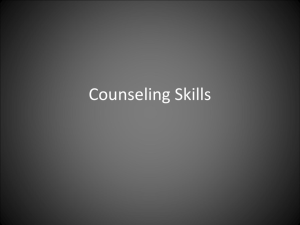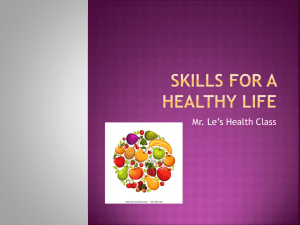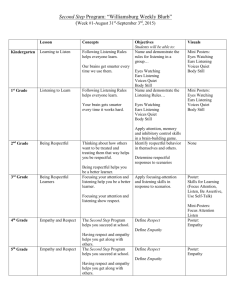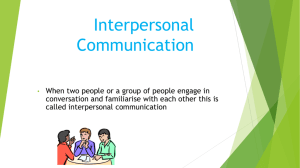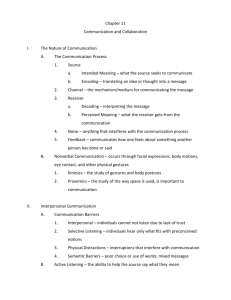Unresolved conflict
advertisement
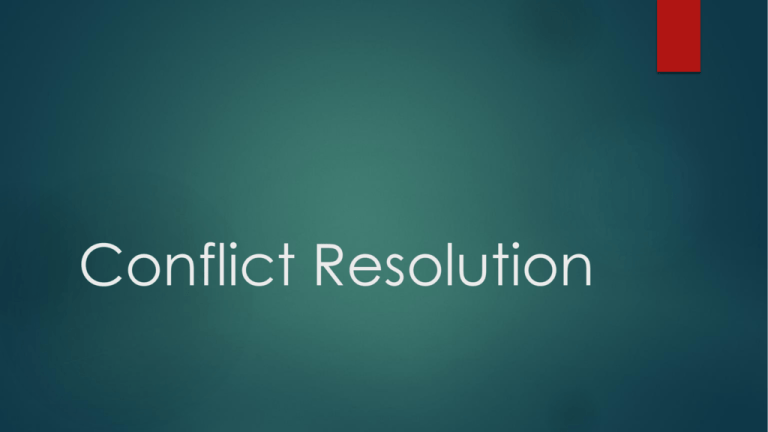
Conflict Resolution What words that you associate with conflict? 1. What is conflict? A disagreement or struggle between two people A clash of opposing ideas Who is the conflict with? Intrapersonal: conflict with self Interpersonal: conflict between individuals Intragroup: between members in a group Intergroup: between groups 2. Identify the 3 types of conflict. 1. Situational conflict – conflict occurring in a functioning relationship because of a certain situation 2. Personality conflict – conflict that occurs due to distinct personality differences 3. Power struggle – conflict occurs because the people may be more concerned with winning the argument than with what they are fighting over Get into groups of 2-3 students and, as a group, determine the 5 of the most common conflicts. Examples of conflict in the world today Work in groups to search newspapers for examples of conflict As a group, use the worksheet to complete the analysis of your article Share a brief summary of your article and conflict analysis with the class 3. What is the action of directing another person’s behavior? control 4. Describe how conflicts can be resolved constructively. People have to want to resolve the conflict. Worksheet: Constructive or Destructive? In constructive conflict, people work together to solve a problem. In destructive conflict, people attack each other not the problem. 4. What tactics are useful to resolving conflicts? 1. Define the problem – put into words why you are upset, listen to why they are upset (don’t assume!) 2. Set limits – discuss only the problem 3. Negotiate – think of possible solutions 4. Get outside help – person should not be involved in the conflict and should not take sides 5. Follow up - make sure everyone agrees with the solution Once in groups of 3, you will receive a set of papers. Shuffle the papers and place them face down on in the middle of the team You will have 2-3 minutes to turn over the pieces of paper one at a time to memorize the correct placement. You must turn it back over before turning over another piece. There can never be more than one number showing at a time. You may turn over each piece as many times as you wish. However, the paper must be placed back in the exact same position that it was when it was turned over. How many numbers did you get correct? What strategy did your team decide to use? What would you do differently if you were to try this activity again? What happens when conflict arises when making a team decision? What are the benefits of having more than one person working on a problem? How can you avoid conflict when making a group decisions? 5. Name one factor that can influence children’s attitudes and behaviors as they grow older The media Interactions with other children Experiences at school 6. What are the advantages to bringing another person in to help solve a problem? 3rd person will be more objective Able to see both sides of disagreement clearly Will have ideas that other two may not have been able to see because of their positions 7. Why is it important to set limits when resolving conflict? Limits are needed to get specific issue settled Otherwise people would Attack Bring each other personally up old issues 8. What are some ways to avoid conflict? Walk away Do not let other irritate you Focus on the positive Change the subject Take a personal stand against physical conflict Do not be imitated into fighting Do not be provoked into fighting 9. Explain the qualities that are shown when a person walks away from conflict. Self-confidence Pride in self Self-discipline Strength It says that the issue is not worth fighting over! 10. Identify interpersonal skills that are useful in dealing with conflict. Using Listening Showing Seeking empathy feedback Looking for clarification of mixed messages Using words to stay on task I-messages Showing emotional self-control Showing physical self-control Using teamwork Picking your time 11. How can interpersonal skills help solve conflict? Needed to figure out a solution to the problem that is causing the conflict: Accurate Skill listening and speaking in timing Using teamwork 12. List 5 communication skills that are important in resolving conflict. Listening Showing Getting empathy feedback Clarifying Using mixed messages I-messages 13. How can careful listening help you understand someone else’s point of view? If you stop and listen, you can understand what the person is trying to get across without letting your emotions get in the way 14. What is required when you want to better understand another person’s message clarification 15. Why is it important to avoid giving people the silent treatment? It creates negative nonverbal messages and builds barriers 16. 2 consequences of physical reactions during conflict Hurt feelings Hurt people Damaged More or destroyed relationships violence Unresolved conflict 17. Healthy physical outlets to help release anger or frustration Sports Running Dancing Listening Clean to music your room 18. How can a competitive spirit sometimes be a barrier? Striving to win at someone else’s expense is contrary to negotiation and compromise In negotiation and compromise, people work together to find solutions. 19. 3 ways to show respect for others Use respectful language Have respectful attitude Work to understand other’s point of view 20. How can you show good timing when resolving a conflict Wait mind until all sides are in a proper frame of Wait until there is enough time to discuss the conflict The person you want to talk to is not distracted 21. How can people be respectful to others during conflicts? Use self-control Show Use understanding respectful language Have a respectful attitude 22. Explain how you can set a positive example of conflict resolution Head off conflict when possible Commit to solving conflicts constructively and nonviolently 23. Why is setting a good example important in conflict situations? You You act as a role model may be able to avoid or prevent the conflict 24. What factors could cause a small disagreement to become a large conflict? Lack of empathy Not listening Not showing respect Dispute become a power struggle


